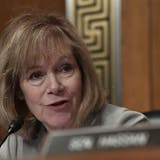FARGO, N.D. – Tammi Kromenaker piled a box of office supplies into her minivan and drove away from the empty downtown abortion clinic where she’d worked half her life. On this cold, windy recent North Dakota morning, she headed toward something new.
It had been a chaotic several months since Kromenaker bought an old office building for the Red River Women's Clinic's new location. The day after she closed on the property in Moorhead, just on the Minnesota side of the Red River, the Supreme Court overturned Roe v. Wade. Even though state courts have for now blocked North Dakota's trigger law that would ban abortion after Roe was overturned, Kromenaker wanted to ensure that abortion access wasn't interrupted, so her new clinic opened 47 days later, on Aug. 10.
Kromenaker braked for a flock of wild turkeys, then she crossed into Minnesota. The border serves as one of the nation's starkest divides on abortion laws: North Dakota among the most restrictive, Minnesota one of the most permissive. For Kromenaker, moving to Minnesota has made life and work easier. Her new building has three times more space. And instead of patients walking past abortion opponents on the downtown Fargo sidewalk, the Moorhead clinic has a spacious parking lot. Now, as volunteer escorts shield patients with rainbow umbrellas, women only hear far-off shouting from the sidewalk: "It's not too late to let your baby live!" "God created that child in your womb!" "Please come back to us!"
But the move has not made it easier to digest how drastically the national abortion landscape has shifted since the ruling.
"I haven't moved on," Kromenaker said. "The day we moved, I was bawling my eyes out. It's bittersweet. [But] there's anger too. We fought long and hard to keep abortion legal in North Dakota … We're not just going to give up and give in."
Kromenaker pulled a leaf blower from her minivan and cleaned the parking lot, then walked into her clinic. The head nurse, Sarah Haeder, had already flipped on the lights and started the ultrasound machine. As Kromenaker got on a call with her attorney about the trigger ban, Haeder answered the main phone.
"Red River Women's Clinic, how can I help you?"
A woman from North Dakota had just found out she was pregnant. She wanted an abortion — but first, she asked if abortion was still legal. Haeder explained that the clinic, previously the only abortion clinic in North Dakota, had moved to Minnesota, and she explained two options: a suction procedure or a medication abortion.


